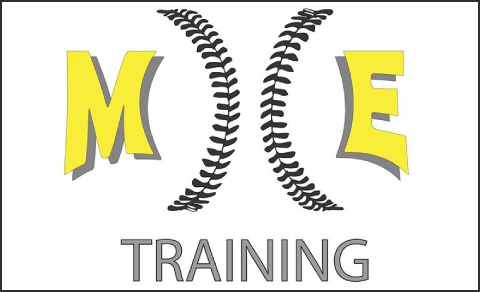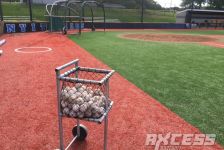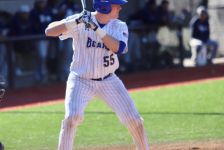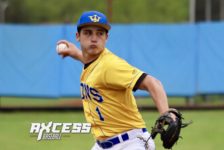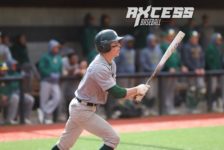Art Canestro was never nervous on the mound–except maybe for this time, he admitted.
Pitching in the first ever game at Coors Field, there was a capacity crowd of 60,000 people despite being a Spring Training game.
“I just remember looking up in the stands and being blinded by the people. It was just a wall of people. I was never nervous pitching, but that time there was definitely some butterflies,” says the current Head Coach of Calhoun HS.

“I didn’t even really get to enjoy it; it was over after eight pitches. I got two pop outs and a ground out and the inning was over,” he added.
That was the closest he got the big leagues, but the left-handed pitcher enjoyed a glorious high school career at Wellington C. Mepham HS. He graduated prior to the inception of the Diamond Award, but he was named to Daily News’ All-Long Island team for his dynamic season that ended against Berner High School (now Massapequa) in the semifinals despite holding a shutout into the 10th inning. It was his only loss of the season.
He was invited to pitch in the Long Island vs. New York City high school All-Star Game at Yankee Stadium.
“It was great,” he said in regards to his experience in that game. “Being 17-years-old pitching in Yankee Stadium was a pretty big thrill,” he added.
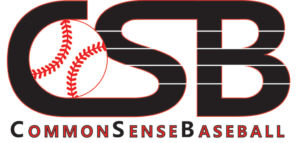
After a solid collegiate career, he was drafted by the New York Yankees in the 46th round out of the New York Institute of Technology (NYIT) in 1988. NYIT was in the midst of their powerhouse days during the 1980s under Head Coach Bob Hirschfield. According to the NYIT archives, the Bears sent 48 of their former athletes to play professional baseball between the years 1977 and 2000. From Canestro’s junior season alone there were six players drafted.
“In those days you either wanted to play for St. John’s, Seton Hall or NYIT,” he said. Canestro’s squad had a great season in 1988 but ultimately got eliminated by Fordham University against future Major Leaguer Pete Harnisch. For his career, Harnisch compiled a collegiate record of 21-3 with a 2.29 ERA and 213 strikeouts over 204 innings pitched. Canestro pitched in the conference tournament and defeated C.W. Post.
“Art was a solid left-handed pitcher for us at NY Tech,” said his Head Coach Bob Hirschfield. “He was very competitive and always wanted to pitch the big game. His teammates loved playing behind him as we battled against some of the better Division-I teams in the country,” he added.
He pitched four seasons in the minor leagues, highlighted by an incredible season as a 21-year-old in 1988 pitching for the Oneonta Yankees. The LHP compiled a sparkling ERA of 1.05 with a record of 7-2 over 77.1 IP, leading his team to a NY-Penn League championship.

To become a Black Diamond call 631-942-2542
After initially beginning the season in relief, he earned himself some spot starts and began the season with a record of 6-0 including a scoreless stretch of 28.1 IP.
“I started really figuring things out,” he said. “I was putting the ball where I wanted it. It helps that when you get to the minor leagues, all you do is talk about baseball in the dugout,” he added.
That successful season, according to Canestro, bought him another three years in the minors.
His career trajectory took a halt the next year, though, after a promotion to the Carolina League pitching for Prince William Cannons (equivalent to Tampa Bay Yankees of High-A). Despite his massive success the previous season, he was relegated to spot starting and bullpen mop-up duties.
“I started noticing I was only coming into games that we were either trailing or winning by a lot. What happens in minor league baseball is there is some politics involved depending on where you were drafted. High draft picks that get a lot of money are usually starting pitchers,” he said.

His lack of a defined role affected his pitching. His record slipped to 7-7 and ERA rose to 4.34.
Coming out of the bullpen changed his arsenal of pitching, he noted.
“I didn’t get to utilize all my pitches out of the bullpen. I was basically a two-pitch pitcher,” he noted. For a pitcher with a fastball topping out in the low 90s, it could be difficult to survive without a third pitch.
That team had future big leaguers in J.T. Snow and Brad Ausmus. Speaking on Ausmus, he said he was a “smart kid from Darmouth that had a handle on the game” so he wasn’t surprised to see that he became a manager for the Detroit Tigers in 2014.
The next season in Spring Training, he recalls hearing a lot of talk about a skinny kid from Panama, who was future 5-time World Series champion Mariano Rivera.
“He was the skinniest guy you ever saw,” he said. He also remembers seeing Derek Jeter in Spring Training that season. The Yankees were in the midst of some lean years, but those two players wound up being the focal point of their dynasty beginning in 1996.
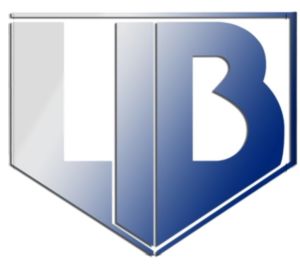
From a personal standpoint, Canestro was assigned to Fort Lauderdale in 1991. He pitched to a 3.98 ERA over 40.2 IP without recording a win or loss primarily as a reliever (two starts).
“People don’t realize you are caught in a numbers game. Everything is run by the organization, they tell the managers who to play. Every year there’s about 70 new players drafted or signed and those guys have to go somewhere,” he said of the nature of minor league baseball.
After being out of the game for the 1993 season, Canestro had bone chips removed from his elbow in 1994 that had been bothering him the previous year. Upon feeling better, he was notified of the work stoppage in Major League Baseball due to the players’ strike.
Hoping to seize the opportunity, he drove down to Florida for an open tryout.with the Yankees. At the entrance, the security guard wouldn’t allow him in.
“I told him I was a player and I even showed my Penn league ring to prove it. He told me, ‘here’s the number, you can call yourself’, so I did and Brian Cashman answered the phone and said ‘no problem I’ll be right out.”

“Cashman came out and told me to come back and throw a bullpen,” he said. Canestro describes the following events in which he drove to a Little Caesar’s to throw the ball against the back wall to see how his arm was feeling.
“The ball was sizzling,” he said.
He wound up performing well and getting signed to be a replacement player for Spring Training which brought him to Coors Field pitching against fill-in professional players. He recalls standing next to NYIT-grad Dave Rodriguez during the National Anthem in the bullpen.
After the Major League players returned back to the game, the organizations basically told the replacement players ‘thank you’, they kept some of them to fill out minor league rosters, but the vast majority, like Canestro, were not retained.
Now without baseball for the first time in his life, he decided to go back to NYIT to finish his degree.
“I always knew I wanted to work with kids,” he said. “He was hired as a phys.ed teacher and began coaching at Mepham.
“It’s a great community. I love coaching and putting kids in the position to be successful. Most kids buy into it,” he said. Calhoun has been a consistently successful program during his six-year tenure and they are set up for another contending season in 2018.
While his playing days are over and he’s now focused on being a great father to his two daughters, Canestro remembers his playing days fondly–especially during his days growing up on Long Island.
“Back then there was only a couple of travel organizations–you had the Long Island Tigers and the Bayside Yankees. I was on the Tigers and we basically had the best players on Long Island and the city–imagine that?”
He recalls facing a team in 1986 filled with three sons of former Major Leaguers (Pete Rose Jr, Lee May Jr and Ken Griffey Jr). He was the starting pitcher and faced Griffey Jr. three times, striking him out in the first two plate appearances.
“I remember after the second strike out, the coach was ripping him pretty good, but he ripped one past the second baseman in his third at bat.”
Those are the types of memories that will last a lifetime–striking out a future (and nearly unanimous) Hall of Famer.
Long Island baseball has featured several big leaguers in its history, and despite Canestro not being among that group, he occupies an important place in that history book.
Follow the author on Twitter @V_Messana

